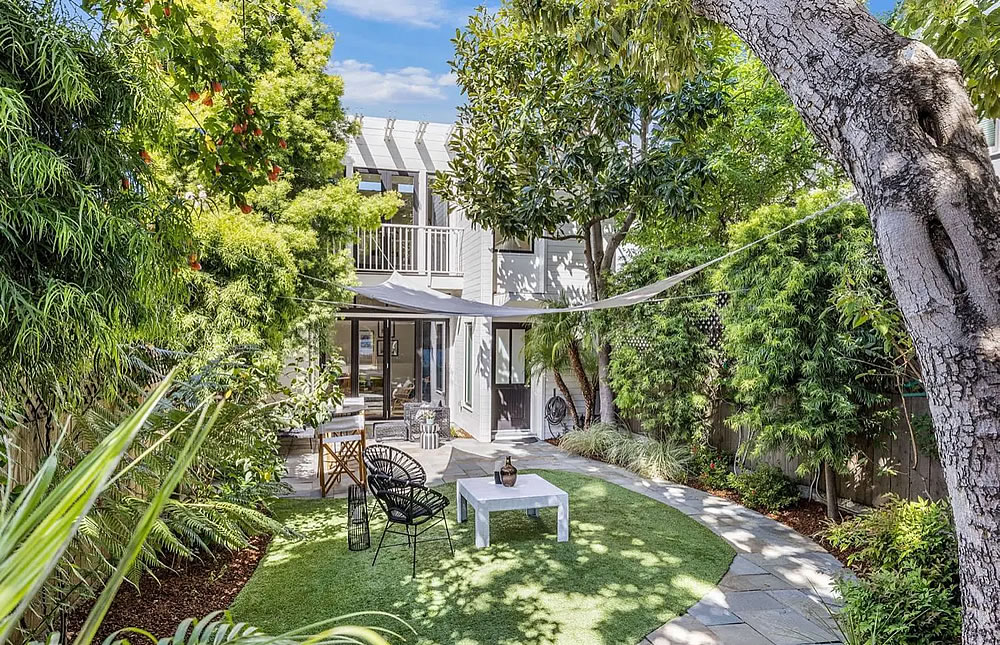Further remodeled and expanded since we featured it back in 2009, the now 2,400-square-foot “modern farmhouse” that’s hidden behind the unassuming fence at 870 Kansas Street, yielding a “private sanctuary in the heart of San Francisco’s Potrero Hill,” quietly traded for $2.450 million in February of 2019.
Having returned to the market priced at $2.595 million a few weeks ago, the resale of 870 Potrero Hill has now closed escrow with a contract price of $2.500 million, representing net appreciation of just 2 percent for the single-family Potrero Hill home since the first quarter of 2019, despite the fact that the widely misreported Case-Shiller Index for “San Francisco” home values is “still up nearly 30 percent!” over the same period of time, having dropped 17 percent over the past year, and the (temporal) pandemic-era squeeze.
And yes, plans to add a garage and rebuild the home’s unassuming fence have been drawn and a permit for the project is close to being issued.








With interest rates substantially higher than in 2019, a relatively more-expensive transaction price demonstrates that quality housing in San Francisco remains in demand.
All the people who no longer want to go into the office need to work from a nice home, and not everyone has moved to Boise and Salt Lake.
Fun fact: this house sold for $85,000 in 1983. If that sounds cheap, if you invested the same $85k in the S&P 500 and reinvested dividends, you would have 72x’d your money and have $6.1mm.
In other words, It’s Not Exactly Cheap, but It Is [getting] Cheaper in San Francisco, despite protestations to the contrary.
Incorrect. This house became more expensive in both absolute and relative terms from the previous sale price. It’s not getting cheaper.
The aggregate can be going one way, contrary to a data point – don’t see how those are at odds
It makes sense to post a story about a house that moved up in price and then explain that it represents things getting cheaper?
How astute. We can’t think of anything that a straight line from the first quarter of 2019 to today might have missed, mislead or misrepresent, in terms of market directionality or how the value of this home has moved.
At the risk of being a troublemaker, most people define “cheapness” in relation to their own situation(s); which is to say that income – not the price of other houses or investments – is the all-important metric that seems to be missing from these discussions.
But not to feel bad: the world as a whole doesn’t seem to get that “adjusted for inflation” – with regard to prices – is basically a circular reference.
Just based on my own experience dealing with these people, I would think that the overwhelming majority of potential buyers in the market for a two and a half million-dollar detached SFH are pretty comfortable with their household income and objectively are not themselves part of the precariat class. If anything, these are the people who, if they have a job, are the ones making the decisions about who and how many to lay off from well-paying corporate jobs at local companies and they aren’t themselves at risk, or if they are, have well-negotiated golden parachutes/golden handshakes.
Prior to the nineteen nineties, I would have agreed with you that most people wouldn’t have been too attuned to the price of surrounding or comparable homes, but I distinctly remember that changing dramatically during the decade preceding the so-called global financial crisis. Those scenes in the 2015 movie The Big Short showing Mark Baum touring around Florida subdivisions with a real estate agent weren’t made up, there were all kinds of actual surveys done at the time that showed that people had in their head, at any given time, a pretty accurate idea of what their home was worth and those results were robust even when controlled for how long ago a particular respondent did their last refinance. The arrival of Zillow and their Zestimates had to contribute to this.
Uhm, OK.
My point was more succinct:
“Real” Price = Nominal price adjusted by changes in income.
(Just as “real” income = Nominal income adjusted by changes in prices.)
Now back to the topic at hand , which is….gee…beats the H*** outta me!
You might have put 10% down in 1983.
If you had invested that same $8300 in the S&P 500 instead of a down payment on this house and had 72x’d your money, you would have $610,000, which is not enough to buy this home.
Not to mention that if you had bought it in 1983 with 10% down, you would have had this place to live over the last 40 years. One could do a lot worse than this lovely house on top of Potrero Hill!
And you have to be realistic about whether you’d have the stomach to buy in 1983 and then hold your investment in the S&P 500 through a 9.1 percent draw down in the year 2000, an 11.9 percent draw down in 2001, a 22.1 percent draw down in 2002, a 37 percent draw down six years later in 2008, a 4.4 percent draw down in 2018 and the 18.1 percent draw down last year. Behavioral economics surveys of actual, real-world investors consistently show that most investors don’t actually get the theoretical gains of the stock market.
The point being, it’s much easier to hold a house through a market downturn and actually realize a capital gain in the real world.
Good point. A liquid market offers immediate temptations that real estate does not.
But you would be living someplace else. Paying rent. You would be paying Uncle Sam & Calif income taxes
Quality of life is important ! Love the place.
> And yes, plans to add a garage … have been drawn and a permit for the project is close to being issued.
Wow, how would that work? Link to plans?
I assume that the owner expects to hand over the plans and the incomplete permitting paperwork to the buyer after COE.
Haha why is there a Nanawall tag? Are they a socketsite sponsor?